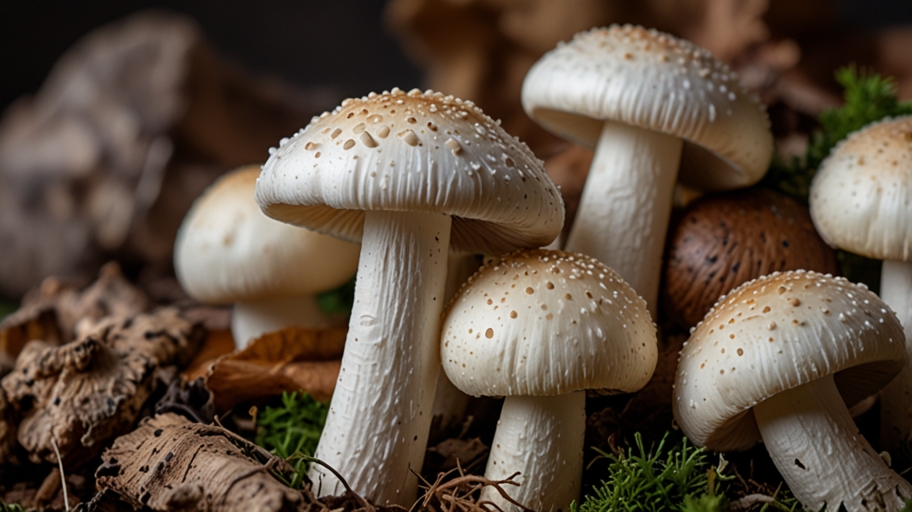Introduction
Picture a small, white mushroom sitting on your plate—simple, tasty, and ready to make any meal better. That’s the button mushroom, a little powerhouse loved by cooks everywhere. Known scientifically as Agaricus bisporus, it’s the most popular mushroom in the U.S., from pizzas to soups. In 2025, button mushrooms are still a big deal—easy to find, good for you, and super versatile. This article covers all you need to know about button mushrooms—what they are, how to use them, their health perks, and why they’re a must-have this year. Let’s dig into the world of this everyday fungi!
What Are Button Mushrooms?
Button mushrooms are small, white, and round, with a mild flavour that fits almost any dish. They’re also called white mushrooms, champignons, or table mushrooms. These little guys are the young version of Agaricus bisporus—as they grow, they turn into cremini (brown) and then portobello mushrooms. In 2025, they’re still the top seller in grocery stores, making up over half of all mushroom sales in the U.S.
Grown indoors on compost, button mushrooms pop up year-round. Their caps start tiny—about an inch across—and stay smooth and firm. They’re not wild but farmed for their clean look and gentle taste. Whether you’re a beginner cook or a pro, these mushrooms are a go-to because they soak up flavours and add a soft, chewy bite to meals.
How Button Mushrooms Grow
Button mushrooms don’t grow like plants—they’re fungi! Farmers start with spores, tiny seeds that turn into a web of threads called mycelium. This web spreads through a mix of manure, straw, and soil in dark, cool rooms. After a few weeks, little white “pins” appear, growing into button mushrooms in just days. By 2025, growers will use high-tech setups to keep them perfect—steady temps around 60°F and lots of moisture.
Harvesting happens fast—workers pick them by hand when caps are small and tight. One batch can yield mushrooms for weeks, making them cheap and plentiful. In 2025, sustainable farms will use recycled waste for compost, keeping this food eco-friendly. It’s a quick, clean process that lands fresh mushrooms on your table.
Why Button Mushrooms Are Popular
Why do people love button mushrooms? They’re easy to find, affordable, and work in many recipes. In 2025, a pound costs about $2-$3 at stores like Walmart or Kroger—way less than fancy mushrooms like shiitake. Their mild taste doesn’t overpower, so they blend into stir-fries, sauces, or salads without stealing the show.
Button mushrooms are also a hit for health buffs. Low in calories but packed with nutrients, they’re a guilt-free add-on. In 2025, with plant-based eating on the rise, button mushrooms shine as a meaty substitute—think burgers or tacos. Their simple charm and enormous benefits keep them a kitchen favourite year after year.

Health Benefits of Button Mushrooms
Button mushrooms are tiny but mighty when it comes to health. One cup (about 70 grams) has just 15 calories, making it perfect for light meals. They’re loaded with B vitamins—like riboflavin and niacin—that help your body turn food into energy. In 2025, studies show they’ve got antioxidants, like selenium, which fight cell damage and may lower cancer risk.
If grown under UV light, they’re a rare veggie source of vitamin D—great for bones in winter. Potassium keeps your heart happy, and fibre aids digestion. With no fat or cholesterol, they’re a clean eat. In 2025, folks will love them for boosting immunity and keeping meals healthy without extra fuss.
How to Pick Fresh Button Mushrooms
Choosing the best button mushrooms is easy with a few tricks. Look for firm, smooth caps—about 1-2 inches wide—with no slimy spots or wrinkles. Fresh ones are bright white, not yellow or brown, and smell earthy, not sour. In 2025, stores like Whole Foods will label them “UV-grown” for extra vitamin D—worth a peek!
Check the gills under the cap—tight and pinkish means they’re young and fresh. Loose, dark gills mean they’re older. Grab a pack with no mushy spots, and you’re set. At farmers’ markets in 2025, you might even find organic ones—the same great taste, just grown without chemicals.
Storing Button Mushrooms
Keep button mushrooms fresh with simple steps. Don’t wash them right away—moisture makes them soggy. Pop them in a paper bag or their original pack with a paper towel to soak up dampness. Stick them in the fridge’s veggie drawer, and they’ll last up to 10 days in 2025’s calm, steady fridges.
Freezing works, too—slice them, blanch them in boiling water for two minutes, then cool and bag them. They’ll keep for months, ready for soups or stews. In 2025, some folks will use airtight containers with vents—fancy but adequate. Fresh or frozen, they’re always on hand.
Cooking with Button Mushrooms
Cooking button mushrooms is a breeze—they’re super flexible. Sauté them in butter with garlic for a quick side—five minutes on medium heat does it. Toss them raw into salads for a soft crunch, or roast them at 400°F with oil and salt for 20 minutes to bring out their flavour. In 2025, air fryers are big—pop them in at 375°F for 10 minutes for a crispy bite.
They shine in soups, too—add sliced buttons to the broth for a hearty bowl. Stuff them with cheese and herbs, bake at 350°F for 15 minutes, and you’ve got a fun appetizer. Their mild taste soaks up spices, making them perfect for any recipe.

Button Mushrooms in Everyday Meals
Button mushrooms fit into daily cooking like a charm. Slice them onto a pizza with pepperoni—they cook right in at 425°F for 15 minutes. Stir them into pasta sauce—think marinara with a mushroom twist—or mix them into scrambled eggs for breakfast. In 2025, they’ll be a hit in veggie tacos—just sauté with onions and cumin.
Grill them whole on skewers with peppers for a summer BBQ, or chop them into a creamy risotto. They’re small but add a big, savoury punch. Home cooks in 2025 swear by them for fast, tasty meals that don’t break the bank.
Button Mushrooms as a Meat Substitute
Going meatless in 2025? Button mushrooms step up. Their chewy texture mimics meat, especially when cooked right. Chop them fine, sauté with soy sauce, and use as a ground beef swap in chilli—same hearty feel, zero cholesterol. Grill whole caps like mini steaks—brush with oil, cook five minutes per side.
They’ve got umami—that deep, savoury taste—making them a plant-based star. Vegan recipes will lean on them hard—think mushroom burgers or sloppy joes. Protein and fibre fill you up without fat, perfect for flexitarian diets.
Where to Buy Button Mushrooms
Finding button mushrooms is a snap. Big chains like Walmart, Target, and Kroger stock them fresh for $2-$3 a pound—look in the produce aisle. Amazon Fresh delivers packs to your door online, often organic, for $4-$5. Farmers’ markets near cities like Chicago or Seattle offer them too—sometimes cheaper, always fresh.
Specialty stores like Whole Foods have pre-sliced or UV-grown options, handy for quick meals. Some Costco bulk packs will be 2 pounds for $6—a steal for prominent families. Wherever you shop, they’re easy to grab year-round.
Growing Button Mushrooms at Home
Want to grow your own? Buy a button mushroom kit online—about $20 from sites like Mushroom Corner. They come with compost and spores. Set it up in a dark, cool spot like a basement. Keep it damp with a spray bottle, and you’ll see tiny caps in 3-4 weeks.
If you don’t have a kit, mix straw and manure, add spawn (mushroom starter), and wait. Temps around 60°F and high humidity are key. In 2025, home growers will share tips on X—small trays that yield 1-2 pounds per flush. It’s fun, fresh, and cuts grocery trips!
Button Mushroom Varieties
Button mushrooms are part of a family. The white button is the youngest—small, pale, mild. Cremini, or baby Bella, comes next—brown, nuttier, same species. Portobellos are the grown-ups—big, dark, meaty. In 2025, all three rule kitchens, but buttons lead for their soft taste and size.
Some stores sell “sliced whites”—pre-cut buttons for speed. Organic versions pop up, too, grown without pesticides. In 2025, UV-treated buttons with extra vitamin D are trending—same mushroom, more nutrition. Pick your fave—they’re all Agaricus bisporus at heart.

Button Mushrooms Trends
In 2025, button mushrooms are riding high. The Mushroom Council says white buttons still top sales, but sliced ones are up—47% of pounds sold, per their 2023 report. Health buffs love them for low calories and antioxidants—X posts call them “nature’s superfood.” Plant-based diets keep them hot, too.
Restaurants lean in—think mushroom coffee or stuffed buttons as appetizers. Home cooks will air-fry them for snacks, a nod to convenience. With sales growing 9% yearly (Grand View Research), they’re a staple that’s only getting bigger.
Cleaning Button Mushrooms
Cleaning button mushrooms is quick and straightforward. Don’t soak them—they get mushy. Brush off dirt with a soft cloth or mushroom brush—$5 at kitchen stores. For stubborn spots, rinse under cool water fast, then pat dry with a towel. No peeling is needed—the skin’s edible.
If the stem is dry, trim the end—a maximum of half an inch. In 2025, some will skip brushes for damp paper towels—it works just as well. Clean the mushrooms right before cooking; wet mushrooms don’t store. Easy prep keeps their flavour intact.
Button Mushrooms vs. Other Mushrooms
How do buttons stack up? Shiitakes are darker, pricier ($10/pound), and bolder—great for Asian dishes. Oyster mushrooms, light and frilly, cost $8/pound and shine in soups. Portobellos, their big cousin, are meatier but less mild. In 2025, buttons win for price and ease—$2-$3/pound, no strong taste.
They’re less fancy than chanterelles ($20/pound) but more common than wild morels. Buttons cook fast and fit anywhere—other mushrooms can be pickier. For everyday meals, they’re the practical champ.
Nutritional Breakdown
One cup of raw button mushrooms (70 grams) packs a punch: 15 calories, 2 grams of protein, 1 gram of fibre, and zero fat. You get 223 mg of potassium—good for your heart—and 11.9 mcg of folate for cell health. B vitamins like niacin (2.5 mg) fuel energy and selenium (6.5 mcg) fight ageing. UV-grown ones add 5-10 mcg of vitamin D.
In 2025, they’ll be a low-carb star—2 grams of carbs total. There will be no sodium or cholesterol—just pure, clean nutrition. They’re a small bite with significant benefits and are easy to love.
Button Mushrooms in History
Button mushrooms go way back. First grown in France in the 1700s, they started in caves near Paris—hence “champignon.” By the 1800s, they hit the U.S., with Pennsylvania leading the charge. In 2025, that state will still grow over 60% of America’s supply, per the USDA.
They were a luxury once—now they’re everywhere. Early farmers used horse manure; today’s compost is high-tech but keeps the old-school vibe. In 2025, their story ties tradition to modern health trends—fungi with roots and reach.
Why it Matter
Button mushrooms matter now because they’re affordable, healthy, and green. Gas prices pinch in 2025, but their low cost and local growth keep them wallet-friendly. Plant-based eating is enormous—they fit right in. Plus, farms recycle waste to grow them, cutting carbon footprints.
They’re simple but powerful—cooks, dietitians, and eco-fans love them. In 2025, X buzzes with “mushroom hacks”—proof they’re still king. From stove to plate, they deliver taste and goodness without fuss.
Conclusion
These mushrooms are your 2025 kitchen MVP—small, white, and ready for anything. At $2-$3 a pound, they’re cheap, packed with vitamins, and perfect for sautéing, stuffing, or swapping for meat. Grow them at home or grab them at the store—they’re always fresh. In a world chasing health and sustainability, these mushrooms nail it. Slice some up, cook them your way, and see why they’ve been a hit for centuries. Button mushrooms are little fungi with a significant impact!
References
- Mushroom Council. (2023). “Ten-Year Trends in Fresh Mushroom Sales.” Retrieved from mushroomcouncil.com.
- USDA. (2025). “Mushroom Production Data.” Retrieved from usda.gov.
- Grand View Research. (2024). “Button Mushroom Products Market Report.” Retrieved from grandviewresearch.com.
- UCLA Health. (2022). “7 Health Benefits of Mushrooms.” Retrieved from uclahealth.org.



